Microsoft Surface 2 Review
by Anand Lal Shimpi on October 21, 2013 12:00 AM EST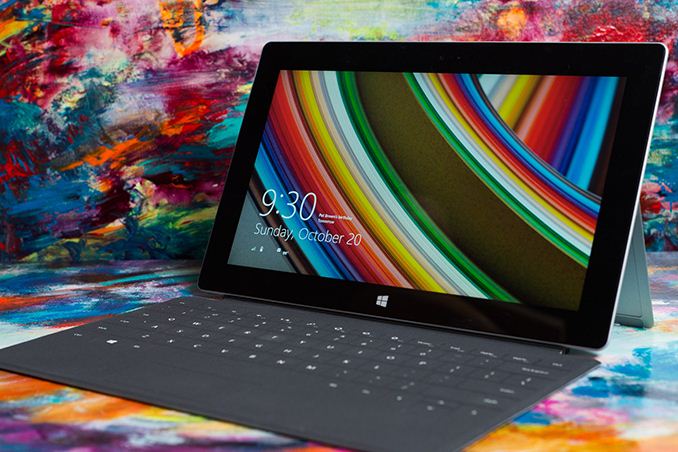
A year ago Microsoft first threw its hat into the tablet race with a new brand, a new OS and a completely new strategy. To make a challenging situation even more difficult, Microsoft chose to go after the traditional tablet market with a device that was neither a tablet nor a notebook.
I was relatively pleased with both Surface devices that launched last year. Surface RT had potential, but it was too slow, needed a price adjustment and of course needed more maturity on the OS side. Surface Pro on the other hand needed to be thinner, needed Haswell and related, it needed better battery life.
With its new commitment to being a devices & services company, Microsoft now joins the ranks of Apple and Google in shipping platforms with annual updates to hardware and software. Last week we saw the software side of the story, with a free update to Windows 8.1. It wasn’t too long ago that Microsoft was charging hundreds of dollars for new OS revisions, but with Apple and Google redefining what users come to expect from both cost and frequency of OS updates, Microsoft had to change.
Today we get the second half of the story. Microsoft’s partners have already announced their Windows 8.1 launch devices, now it’s time for Microsoft.
I’ll start with Surface 2, which sees the largest number of physical changes compared to its predecessor. It’s still built using the same injection molded magnesium manufacturing process (VaporMg, pronounced vapor mag), but moves to a 2-piece VaporMg design similar to Surface Pro. There’s the VaporMg tub and the kickstand.
The look and feel of the device see substantial updates. The finish of Surface 2 is now a light silver. Not only does the new finish not pick up grease/fingerprints like the previous black finish, but it also has a slightly more textured feel to it. Staring at Surface 2’s display head on you get a little bit of a silver border around the display, a nice touch. Surface 2’s construction feels every bit as solid and expensive as its predecessor. Both devices remain the absolute best built Windows tablets/notebooks on the market.
Curiously enough both Surface 2 and Surface Pro 2 ditch the Windows 8 logo on the back of the kickstand in favor of a Surface logo. The devices in general continue to be devoid of excess branding. Both have a capacitive Windows button up front, the aforementioned Surface logo around back and some branding on their respective chargers. There are no stickers to remove, and no COA labels to worry about. It may be years later than we’d hoped, but Microsoft finally gets the beauty of clean aesthetics.
The overall dimensions of Surface 2 don’t change much compared to its predecessor. We’re still dealing with the same 10.6-inch display size, although it sees an update to a 1080p panel with improved color accuracy. The panel size determines the overall device footprint, which explains why that doesn’t change this round. Thickness goes down a small amount from 0.37-inches to 0.35. The reduction is very subtle but helps contribute to the device feeling more right in hand.
Weight improves slightly if you compare Surface 2 to Surface RT. While the latter weighed in at 1.5 lbs, Microsoft lists Surface 2 as weighing less than 1.49 lbs. The somewhat vague spec is designed to take into account variations in manufacturing. Microsoft encouraged me to weigh my Surface 2 review sample, which came in at 1.45 lbs compared to a flat 1.50 lbs for Surface RT. It’s a small difference, but a definite step in the right direction. If the rumors of a lighter iPad 5 are true however, I do wonder if Microsoft should’ve been a bit more aggressive on the weight reduction front this round.
Just as before, Microsoft stresses the importance of looking at weight distribution not just overall weight specifications. Truth be told, Surface 2 doesn’t feel as heavy as the iPad despite having very similar weight specs.
A big part of the Surface story is the device’s integrated kickstand. The best way to talk about the improvements to the kickstand in Surface 2 (and Surface Pro 2) is to quote what I said about the previous design:
“The more I use Surface (Pro and RT) the more I feel that Microsoft needs to pursue something a bit more flexible than the fixed 26-degree kickstand. The biggest issue by far is in-lap use with one of the keyboard covers attached. Depending on your seating position, the 26-degree angle that the kickstand opens at might be too small. Mechanically I don’t know the right solution for Microsoft but I do feel like for the kickstand to realize its true potential, it needs to be able to open and hold at multiple angles. It doesn’t necessarily need to have support for infinite angles, maybe even a few would work, but I do believe it’s necessary going forward.”
Well, wouldn’t you know, Microsoft listened. Surface 2 and Surface Pro 2 both feature a new, 2-stage kickstand. You still get the same solid action, same sound and even the same 24-degree opening angle, but now there’s a second stop in the kickstand’s travel at 40-degrees. The 2-stage design almost completely addresses my issues with the first generation of Surface tablets. While the 24-degree stop is perfect for desk use, the 40-degree stop is ideal for in-lap use. The second stop keeps me from having to strain my neck looking down at the display when I’m typing in cramped quarters (e.g. having to type out this review in the back of a car heading to an airport).
Moving between stops on the new kickstand feels natural, and the new kickstand feels every bit as robust as its predecessor.
I don’t know that Microsoft has perfected the design though. I could still use another stop (or two). Perhaps one at 15-degrees for the on-chest use case if I’m laying down with the tablet on my chest watching a movie. A real issue created by the 40-degree stop is now I need even more leg/thigh/lap-space to support the device. Since there’s no support to hold the display up until you get to the kickstand, you need to make sure that the kickstand has a place to rest when open at its widest angle. I don’t know the right mechanical solution to this concern, but I still feel like Microsoft has some more work ahead of it on the kickstand front.
Behind the kickstand is a repositioned microSD card slot. It’s now further away from the kickstand hinge.
The ports/buttons around the edges of Surface 2 haven’t really changed compared to Surface RT. On the left you’ll find volume up/down buttons (which are appreciably clickier compared to my Surface RT review sample), a headphone jack and one of two speaker ports. On the top right there’s a power/lock button. On the right side you’ll find the other speaker port, micro HDMI output and a USB 3.0 port (new for Surface 2, RT only supported USB 2.0). All of the Surface devices retain the same custom, magnetic power connector as before.
Along the bottom there’s a slightly updated accessory connector and channel for accepting Surface’s famed keyboard covers, as well as new accessories this round. All first generation Surface accessories are supported.
Both front and rear facing cameras get a big upgrade with Surface 2. Surface RT shipped with two 1.2MP cameras, while Surface 2 moves to a 3.5MP front facing camera and a 5MP rear facing camera.
Internally, the upgrades are even more substantial. NVIDIA’s Tegra 3 is out of the picture, replaced by a far faster Tegra 4 SoC. That’s four ARM Cortex A15 cores running at up to 1.7GHz (1.9GHz with only one core active), as well as a fifth power saver core that actually sees some use this time (more on this later).
WiFi remains dual-band 2-stream 802.11n on both Surface 2 and Surface Pro 2, although whatever peak performance issues plagued me on Surface RT seem to be resolved (I could hit 120Mbps max transfers over 5GHz 802.11n).
The tablet still ships with 2GB of memory, but now leverages a 64-bit wide memory interface. On the storage side the options are still 32GB or 64GB of eMMC.
| Microsoft Surface 2/RT Comparison | ||||||||
| Surface 2 | Surface RT | |||||||
| Dimensions | 10.81 x 6.79 x 0.35" | 10.81 x 6.77 x 0.37" | ||||||
| Display | 10.6-inch 1920 x 1080 w/ Improved Color Accuracy | 10.6-inch 1366 x 768 PLS | ||||||
| Weight | Less than 1.49 lbs | 1.5 lbs | ||||||
| Processor | NVIDIA Tegra 4 1.7GHz | NVIDIA Tegra 3 | ||||||
| Connectivity | 802.11n WiFi | 802.11n WiFi | ||||||
| Camera | 3.5MP front facing, 5MP rear facing | 1.2MP front facing, 1.2MP rear facing | ||||||
| Memory | 2GB | 2GB | ||||||
| Storage | 32GB or 64GB eMMC | 32GB or 64GB | ||||||
| Battery | 31.5 Wh | 31.5 Wh | ||||||
| Starting Price | $449 | $349 | ||||||
Battery capacity is still 31.5Wh and Surface 2 still ships with a 24W charger. Surface 2 will draw 10W at the wall while charging, the over-specced adapter is designed to be able to power the system at full load without impacting charge times.
On the software front, Surface 2 ships with Windows RT 8.1 and a full copy of Office 2013 RT Home & Student Edition. Pricing starts at $449 for a 32GB model, or $549 for the 64GB version. Touch and Type covers continue to be sold separately at $119 and $129, respectively.


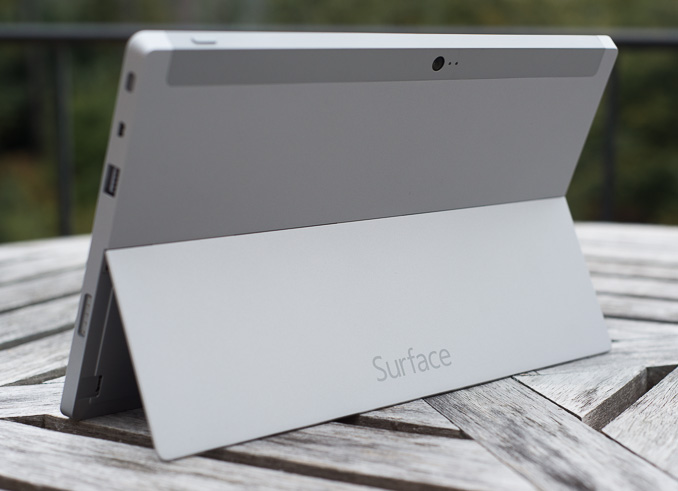
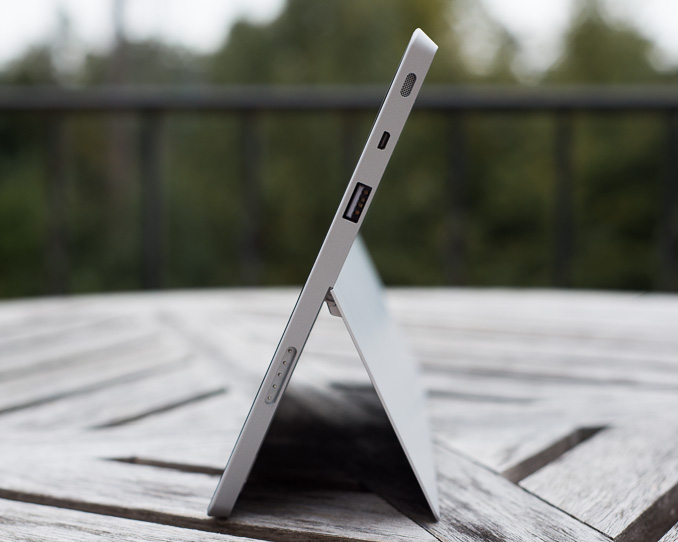
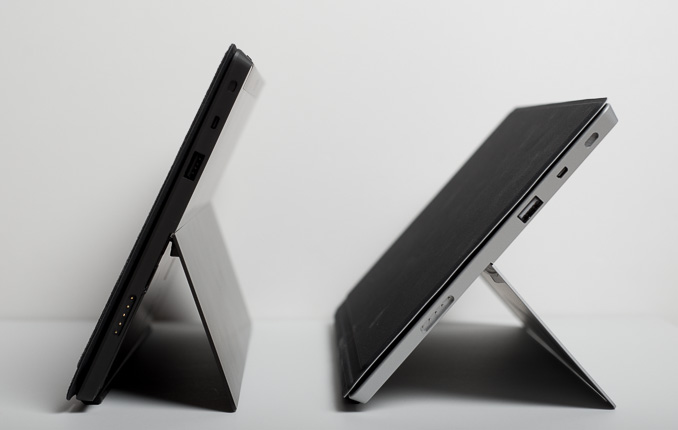
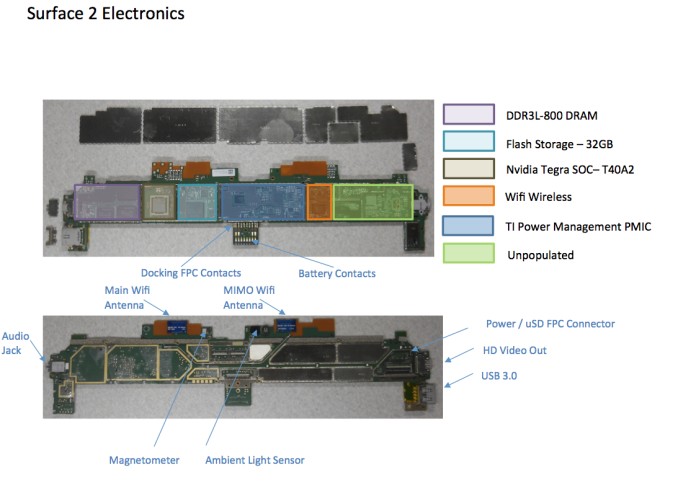








139 Comments
View All Comments
Daniel Egger - Monday, October 21, 2013 - link
Have you actually looked around in the Store? Half a dozen Solitaire clones and a few Poker games but that's about it. He prefers playing more exotic Solitaire versions, Skat, Schafkopf, Doppelkopf, Bridge -- in a nutshell anything that's not Klondike or Poker and you wouldn't believe how many CDs and DVDs with Windows games he has that actually contain hundreds to thousands *unique* card games.Wolfpup - Thursday, October 31, 2013 - link
I'm SERIOUSLY considering buying Surface 2 for exactly this reason, BUT I'm still paranoid she's going to be able to break it, install malware from the Windows store or SOMETHING...chizow - Monday, October 21, 2013 - link
Really wish there was a Bay Trail-T in this Surface 2 chassis, I'd pay $500 for that in a heartbeat for the full x86 Win8.1 support. I still feel Surface Pro 2 is too expensive for what it is, but Windows RT just isn't flexible enough with app support to drop to the ARM-based Surface 2.Instead I'll probably look at the Asus Transformer T100 instead.
Braumin - Monday, October 21, 2013 - link
On the last go around, I would have agreed with you. The Surface RT should have come with Clovertrail - it was faster than Tegra 3, and the app store was pretty much empty on day 1.Now though, I have an use a Surface RT (just upgraded to 8.1) and honestly I don't think x86 is really needed in this kind of device. The desktop is not great with touch, nor with something this small. The app store is way better than it was now. The graphics performance of Tegra 4 is way better than Bay Trail too. CPU performance is still lower of course.
Also, this go around there seems to be some excellent choices on the OEM side which are all using Bay Trail, so if a guy wants x86, there's plenty of choice! The Dell Venue Pro 11 looks excellent, and I'm interested in seeing how the 8" tablets do. The price is certainly right from both Dell and Lenovo. Last year, the OEMs didn't know what to make so everything they made did flips and twists, and no one really made a good tablet.
stanwood - Monday, October 21, 2013 - link
Braumin, you touch on exactly the issue I'm facing in choosing an inexpensive tablet for my mother. Like most people, she is not shopping cross-platform. It's going to run Windows. But should it be a Surface 2 with Tegra 4 or maybe a Venue Pro 11 with Bay Trail? While I appreciate the performance comparison with ARM tablets here I hope we see a Bay Trail table review with comparisons to Surface 2.Braumin - Wednesday, October 23, 2013 - link
It's a tough call I would wait and see what the Venue Pro 11 looks like. The RT side though is perfect for people who don't need to run x86 apps. It's going to get no viruses, it won't get bloated over time. They won't be able to install junk in the browser or system tray that slows the machine down and kills the battery.Personally I'd get a Surface 2, or possibly a Lumia 2520. They cost a bit more but the quality of the Surface is really at the top end.
heelo - Monday, October 21, 2013 - link
"I’d love to see Surface 2 with type cover retail for $399, I feel like at that price point it’d be at least a competitive sell."Part of me thinks that MS needs to stay the course here with the "premium tablet as budget laptop" approach that they've adopted with the Surface RT models. I feel like the "one device instead of two" marketing pitch requires a premium angle, and I think that's the build quality and fit and finish. With this approach, MS doesn't have the same luxury the Android competitors had in being able to undercut the iPad by actually selling less device (not to mention the fact that MS needs to run the program with legitimate P&L considerations, rather than zero-margin strategic market initiatives like the Nexus and Kindle programs).
Yet another part of me agrees with Anand, and believes that "Surface + cover for $399" should be a design requirement for Surface 3.
Perhaps the answer is for MS to create a Nexus-like program where they partner with certain OEMs and have them produce $299-level 10" RT devices that have their own (presumably less robust) kickstands and incorporate the Surface keyboard cover connectors? It may not be possible to produce something viable at that price point today, but maybe next summer?
flyingpants1 - Monday, October 21, 2013 - link
Well price competition is pretty important. At $399 it would compete price wise with the Nexus 10, and $100 cheaper than an iPad, maybe then some people would actually buy it.savagemike - Monday, October 21, 2013 - link
With a type cover then probably closer to $200 cheaper and I think that is where they'd need to be.savagemike - Monday, October 21, 2013 - link
The problem is that the Surface with keyboard cover is pretty much the same money as an iPad with any number of keyboard covers which are available for it. It might come in $30 less or so but that is not enough to drive decisions. And chances are more than high that in a week Apple is going to launch a new ipad which will surely have something new.The only reason to recommend a surface to anyone over an iPad is Office and honestly I think MS overestimates the value of Office to most consumers. Unless you need it for work or it is required for school then it really is not needed. If you do need Office for work then there is a decent chance you will be sporting a laptop or Surface Pro. If for school then maybe. But I think you've found a pretty small market there.
End of the day the only thing which will help them with this round of Surface and RT is that they are probably clever enough not to build so many up front. So the write-down will not be as big at the end of this cycle.
MS has deep pockets though and if this segment is important to them then they'll be back.